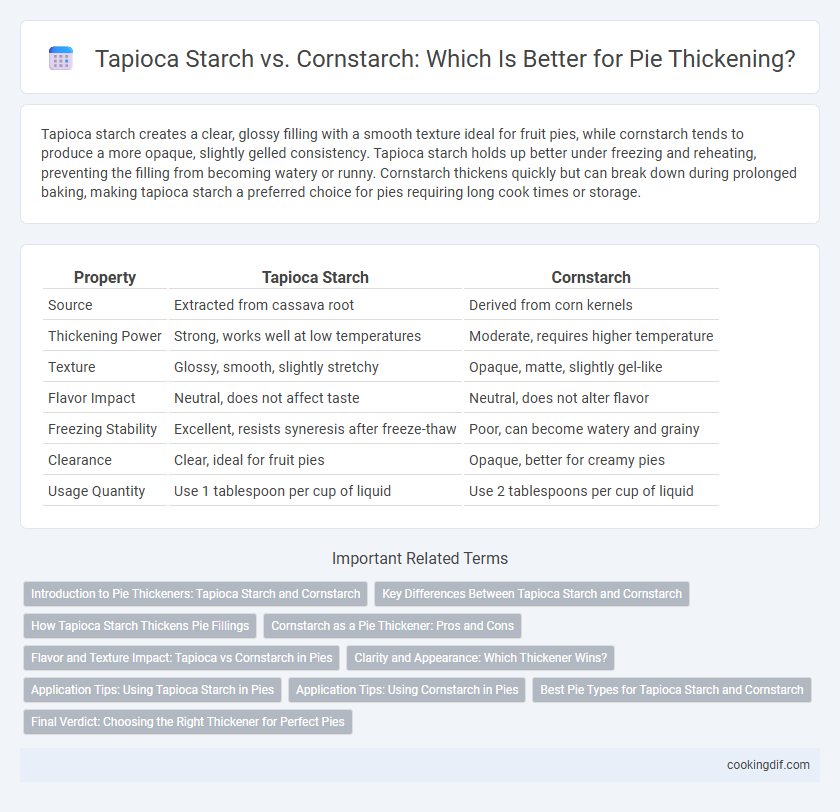Tapioca starch creates a clear, glossy filling with a smooth texture ideal for fruit pies, while cornstarch tends to produce a more opaque, slightly gelled consistency. Tapioca starch holds up better under freezing and reheating, preventing the filling from becoming watery or runny. Cornstarch thickens quickly but can break down during prolonged baking, making tapioca starch a preferred choice for pies requiring long cook times or storage.
Table of Comparison
| Property | Tapioca Starch | Cornstarch |
|---|---|---|
| Source | Extracted from cassava root | Derived from corn kernels |
| Thickening Power | Strong, works well at low temperatures | Moderate, requires higher temperature |
| Texture | Glossy, smooth, slightly stretchy | Opaque, matte, slightly gel-like |
| Flavor Impact | Neutral, does not affect taste | Neutral, does not alter flavor |
| Freezing Stability | Excellent, resists syneresis after freeze-thaw | Poor, can become watery and grainy |
| Clearance | Clear, ideal for fruit pies | Opaque, better for creamy pies |
| Usage Quantity | Use 1 tablespoon per cup of liquid | Use 2 tablespoons per cup of liquid |
Introduction to Pie Thickeners: Tapioca Starch and Cornstarch
Tapioca starch and cornstarch are popular thickeners used in pie fillings, each offering unique textures and properties. Tapioca starch creates a glossy, translucent finish and maintains thickness even after freezing, making it ideal for fruit pies. Cornstarch provides a smooth, matte appearance but can break down or become watery upon freezing or prolonged cooking, requiring cautious use in pie recipes.
Key Differences Between Tapioca Starch and Cornstarch
Tapioca starch and cornstarch differ primarily in their thickening properties and texture outcomes in pie fillings. Tapioca starch creates a glossy, clear finish and remains stable under prolonged heat or freezing, making it ideal for fruit pies requiring a shiny, smooth appearance. Cornstarch thickens quickly but can turn opaque and may break down when reheated, resulting in a less stable filling texture compared to tapioca starch.
How Tapioca Starch Thickens Pie Fillings
Tapioca starch thickens pie fillings through its unique gel-forming properties, creating a clear, glossy, and elastic texture that sets well when cooled. Its small granules swell quickly when heated, absorbing liquid efficiently without breaking down as easily as cornstarch, making it ideal for fruit pies with high acidity or moisture. Unlike cornstarch, tapioca starch maintains stability during freezing and thawing, preventing weeping and ensuring a consistent, smooth filling.
Cornstarch as a Pie Thickener: Pros and Cons
Cornstarch is a popular pie thickener known for creating a clear, glossy filling with a smooth texture, making it ideal for fruit pies. It thickens quickly and holds up well to freezing and reheating, but can sometimes impart a slightly chalky taste and may break down under prolonged heat exposure. While cornstarch provides reliable thickening, it requires precise measurement to avoid a gummy consistency, especially in pies with high acidity or moisture content.
Flavor and Texture Impact: Tapioca vs Cornstarch in Pies
Tapioca starch imparts a clearer, more glossy finish with a slightly chewy texture, enhancing fruit pies without altering their natural flavor. Cornstarch creates a more opaque, matte appearance and yields a smoother, firmer filling, which can sometimes mute delicate fruit flavors. The choice between tapioca and cornstarch directly affects the pie's mouthfeel and visual appeal, making tapioca preferable for juicy, vibrant fillings and cornstarch suitable for creamier pies.
Clarity and Appearance: Which Thickener Wins?
Tapioca starch creates a glossy, clear filling that enhances the pie's visual appeal, making fruit colors more vibrant and attractive. Cornstarch tends to produce a slightly cloudy or opaque filling, which can dull the bright, fresh look of fruits in the pie. For optimal clarity and appearance, tapioca starch is the preferred thickener in pie recipes.
Application Tips: Using Tapioca Starch in Pies
Tapioca starch creates a clearer, glossy filling ideal for fruit pies like cherry or blueberry, enhancing visual appeal while maintaining a smooth texture. Use 1 to 2 tablespoons per cup of liquid, dissolving it in cold water before adding to the hot filling to prevent clumping and achieve even thickening. Avoid overcooking as excessive heat can break down tapioca starch, leading to a thinner filling after cooling.
Application Tips: Using Cornstarch in Pies
Cornstarch is an effective thickening agent for fruit pies, best added towards the end of cooking to prevent over-thickening or a starchy taste. Use about 1 to 2 tablespoons of cornstarch per cup of liquid, mixing it with a small amount of cold water to create a slurry before incorporating it into the pie filling. Avoid excessive heat or prolonged cooking once cornstarch is added, as this can break down its thickening power and result in a runny filling.
Best Pie Types for Tapioca Starch and Cornstarch
Tapioca starch excels as a thickener in fruit pies, especially those with berries, cherries, and tropical fruits, due to its clear, glossy finish and ability to maintain thickness when frozen or reheated. Cornstarch works best in creamy pies and custards like lemon meringue or pumpkin, offering a smooth, opaque consistency but can break down when frozen or overcooked. Choosing between tapioca starch and cornstarch depends on the pie's filling texture and whether the pie will be stored or reheated.
Final Verdict: Choosing the Right Thickener for Perfect Pies
Tapioca starch creates a glossy, clear filling that remains stable after freezing and reheating, making it ideal for fruit pies with a tender texture. Cornstarch thickens quickly and yields a more opaque, slightly gelled consistency, best suited for pies eaten fresh and served warm. Choosing tapioca starch ensures a smoother, more resilient filling, while cornstarch works well for immediate consumption pies with a firmer set.
Tapioca starch vs cornstarch for pie thickening Infographic

 cookingdif.com
cookingdif.com